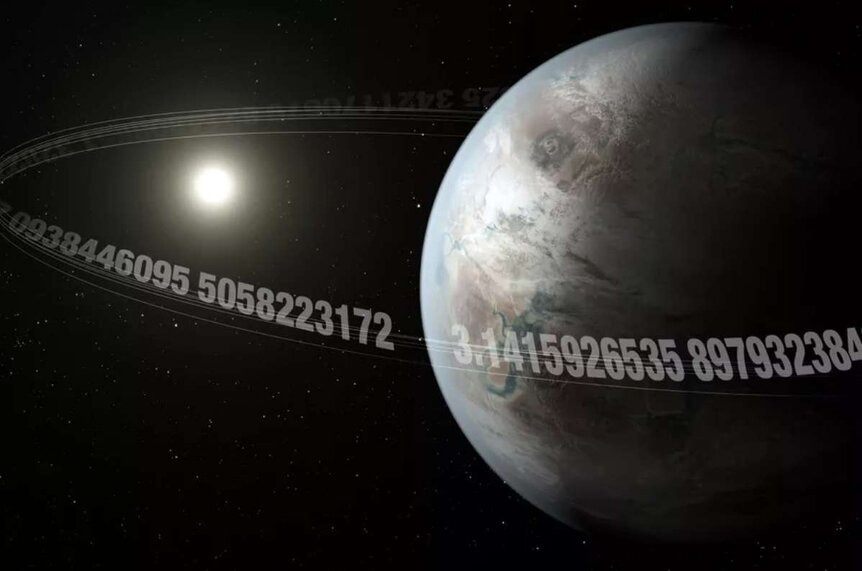Create a free profile to get unlimited access to exclusive videos, sweepstakes, and more!
Slice into this 'Pi Planet' that swiftly orbits its star every 3.14 days

Like Obi-Wan's famous characterization of The Force as an elemental entity that surrounds us and penetrates us, the mysterious number of pi is a permanence whose presence is everywhere — even apparently in heavenly bodies orbiting ultracool stars.
Pi is represented by π, the 16th letter of the Greek alphabet, and is a universal mathematical constant as regular as the rising sun, calculated out as the ratio of a circle's circumference to its diameter. Equal to its approximation of 3.14159, it exists in all arenas of mathematics, physics, and nature.
No matter how big or how small a circle is, pi will always figure out to be the exact same number. Pi is also an irrational number which cannot be expressed by just a simple fraction because it's what mathematicians define as an "infinite decimal," meaning that after the decimal point, the digits go on forever. Pi was first discovered by ancient Babylonians nearly 4,000 years ago and acquired its first calculation by the mathematician Archimedes of Syracuse (287-212 B.C.).
Proving that there is a synchronicity to the cosmos, a new paper published online in The Astronomical Journal reveals an exoplanet that swiftly circles its home star every 3.14 Earth days (181,000 miles per hour), a perfect approximation of the magical mathematical constant of pi.
According to the study led by Prajwal Niraula and Julien de Wit and whimsically titled, "Pi Earth: a 3.14-day Earth-sized Planet from K2's Kitchen Served Warm by the SPECULOOS Team," this alien world known as K2-315b revolves around a dwarf star which exists 186 light-years from Earth.
K2-315b was first detected in data acquired on the K2 mission of NASA's Keppler Space Telescope, back in 2017, then was further confirmed employing direct observations by a network of ground-based telescopes in northern Chile this year called SPECULOOS (Search for Habitable Planets Eclipsing Ultra-cool Stars).
"The planet moves like clockwork," explained Niraula, a graduate student in the Department of Earth, Atmospheric and Planetary Sciences at the Massachusetts Institute of Technology.
K2-315b is the 315th alien world found by applying Keppler's K2 data, and the discovery nearly nailed another uncanny association to the number pi and its symmetry, missing by only one exoplanet!
Niraula and his international crew estimate that K2-315b measures out to be nearly 95% as wide as Earth, which would make it most likely a rocky planet, but the specifics on that matter have yet to be determined exactly.
The planet's mother star is only one-fifth the size of our sun and much cooler. However, K2-315b's intimate orbit close to its star would make this newly revealed terrestrial world far too hot for habitation, but the perfect oven temperature for baking an actual edible pie.
Named after the famous astronomer/scientist Johannes Kepler, NASA's Kepler Space Telescope was launched in 2009 to survey a wide segment of Earth's corner of the Milky Way to discover Earth-size exoplanets in habitable "Goldilocks Zones."
After nine years of peering into the void, it was finally retired by NASA at the end of 2018 after its fuel system was depleted. Over the course of its fruitful mission, Kepler monitored over 200,000 stars for four straight years during its prime. While operating during its K2 mission, when K2-315b was first spotted in 2017, it investigated 20,000 fresh stars every three months. Its legacy unveiled the fact that our mysterious night sky was stuffed with billions of unknown planets.
Kepler faded out of operation two years ago, but not until it left behind data on 530,506 observed stars and 4,284 exoplanet discoveries outside our solar system, some of which could be potential destinations for future human colonization.
"Everyone needs a bit of fun these days," added co-author Julien de Wit, of MIT’s Kavli Institute for Astrophysics and Space Research. “We now know we can mine and extract planets from archival data, and hopefully there will be no planets left behind, especially these really important ones that have a high impact.”





























